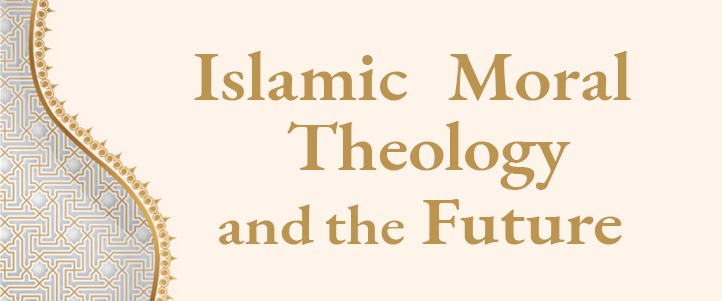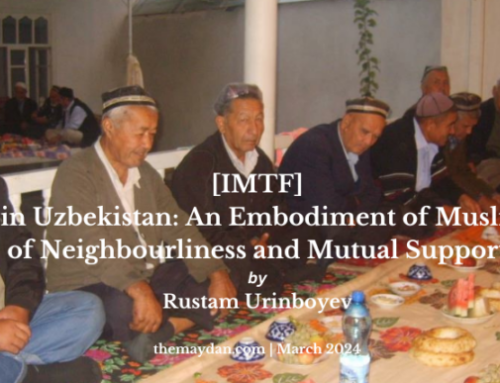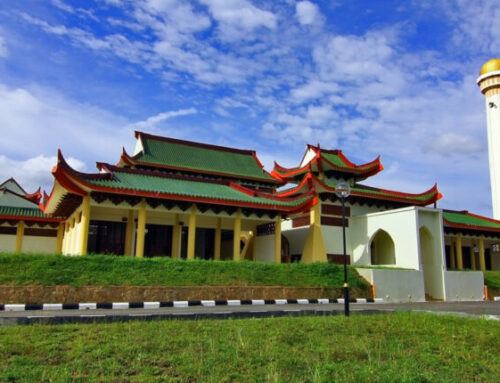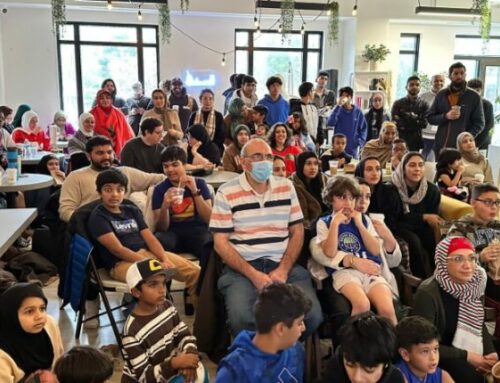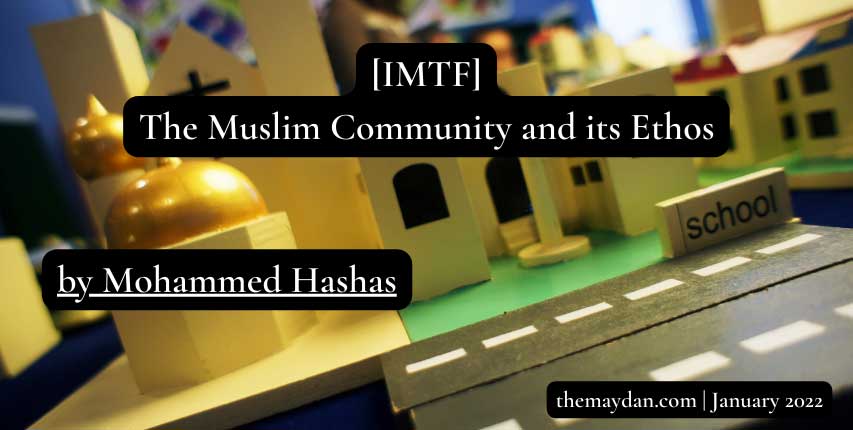
The Muslim Community and its Ethos
The meaning of “community” changes as human societies develop new social and political orders. This is true of any term: a part of it remains tethered to past meanings, and a part grows in response to new developments and novel contexts. Language is a carrier of human memory, and faith is an important part of this memory, thus the intersections between language, faith, and the political writ large. If the context is not considered, faith stands still, and so does language. They all need to be perpetually reinterpreted to be filled with new energy and insights. This essay responds to questions raised by the Islamic Moral Theology and the Future project as to what “community” could mean in contemporary times from an Islamic perspective.
The famous hadith narrated by Imams Bukhari and Muslim which distinguishes between islām, īmān, and iḥsān is constructive here and can be used to reinterpret the meaning of the community in Islam in our historical moment. First, the hadith equates the basic meaning of Islam with its five pillars or rituals: the shahāda (testimony of the Oneness of God/Allah), the obligatory prayers, the fast of Ramadan, the obligatory charity of Zakat, and the Hajj pilgrimage. Second, it defines īmān as six pillars, which are belief in: God, His Angels, His Books, His Messengers, the Last Day (i.e. Judgment Day), and Destiny. Finally, iḥsān, which is often translated as benevolence or excellence, is defined in terms of service to God as if we could see Him and He could see us. Iḥsān is the moral culmination of basic rituals, which guide us in this physical world, and foundational beliefs, which guide us in the metaphysical world, through acts that start from the self to serve His Creation. If islām and īmān are inward looking, oriented towards the individual and society/community, iḥsān is fully outward looking. It overcomes the boundaries of the household and the neighborhood to reach larger spaces and contexts. It takes faith to its universalist, and indeed cosmic, dimension.
“If islām and īmān are inward looking, oriented towards the individual and society/community, iḥsān is fully outward looking. It overcomes the boundaries of the household and the neighborhood to reach larger spaces and contexts. It takes faith to its universalist, and indeed cosmic, dimension.“
The community is first and foremost at home. The individual is the cornerstone of faith. But the individual in isolation does not matter; why would an individual alone on an island need ethics or laws in the first place? The household, however, does matter, because it is where values are tested, and where disagreements need management. Home is, first of all, family and friends. It is with them that we learn the basics of life, language, and faith. Islam grows at home first. It was the Prophet’s wife Khadija who first believed in Muhammad when he narrated to her the first moments of revelation he experienced in the Cave of Hira’. It was his uncle Abu Talib who believed in him next, then his close friend Abu Bakr, who later became the first Rightly Guided Caliph. Muhammad’s history of excellent ethics before revelation at the age of forty was already a testament to his good character. He was already respected and known as the “amīn,” the trustworthy, even prior to revelation.
The community is local, outside the home. The Prophet preached in silence for ten full years among his tribe in Mecca before moving to Medina to construct the first official pluralist community of believers. Though it was intolerable for a tribe to repudiate one of its members, because of the strong sense of kinship and honor in Arabia at the time, most members of the Prophet’s tribe of Quraysh discredited him, tried to assassinate him, and tortured his companions to prevent him from preaching the new religion. It was imān (faith) that provided the Prophet and his companions with the immense energy needed for resistance and perseverance in these trying circumstances. They lived their faith in a hostile context, and they coped with it non-violently, through a grand internal jihād, before the external jihād of legitimate resistance was allowed (albeit with extreme caution and strict humanitarian rules).
The Community is cosmopolitan. Though Muslims became the majority in Medina, with the Prophet serving as the city’s leader, and Islamic teachings guiding its main (but not only) laws, the city’s multicultural spirit remained. The Jewish clans resident in the city were considered part of this newly composed umma or “community of believers.” This right to coexistence was extended later to the Christians as People of the Book, and also to the Zoroastrians and Hindus when Muslims ruled Persia and India, respectively.
“…for faith to stand the trying times of history it needs a broader community. It needs believers, mosques or churches or temples, and charities to flourish within the community first, otherwise it cannot sustain itself.”
To be recognized as a religious minority by the majority faith community was at the time a revolutionary model of tolerance and respect, and one that generally strengthened the communities governed by Muslims. The point here is that for faith to stand the trying times of history it needs a broader community. It needs believers, mosques or churches or temples, and charities to flourish within the community first, otherwise it cannot sustain itself. The community not only maintains religious rituals, but also engages in public affairs, and builds society. The religious ethos is not made to stay indoors; it is rooted in inward reflections and energy, but then grows outward to share the energy and the creativity it nurtures in all fields of life. Islam has been genuine in recognizing this primordial right to other religions, and it set a model of multicultural coexistence in medieval times.
The community is universalist. Classical Muslim jurists were often an independent authority from the political rulers, and this afforded them the freedom to follow the ethical spirit of the sharī‘a, based on the common good, and to closely match the needs of the people as long as this did not contradict the ethical principles of human nature, al-fitra al-insāniyya, that the sharī‘a upholds. According to the famed thinker al-Ghazali (d. 1111), the Divine Legislator’s objectives, later known as al-kulliyāt al-khams (the five major sharī‘a values), are as follows: the preservation of religion, life, intellect, offspring, and property. Since then, scholars have expanded on these five major values, which are considered universal. Today some scholars, when referring to these values, name the second value (life) first, rather than religion. Al-Ghazali, as a towering philosopher and theologian, certainly was mindful of the order he presented, and it was not a slip of the pen that he put “religion” before “life.” This has one simple but vital explanation: that religion for him is the source of the preservation of life, and the protector of all other values and their derivatives. His understanding of religion was comprehensive. Exploring its linguistic connotations, his conception of religion (dīn) was that it was a “dayn” (debt), an existential debt or deposit to protect, maintain, and live by. That is, from this Ghazalian perspective, the community can stand and flourish when it has a uniting bond like that of religion, which gives meaning to the self, the community, and humanity. These values reflect the basics of the Islamic worldview, and they are just as important and relevant today as they were in al-Ghazali’s time.
The community today. But how are the above-mentioned interpretations of the community viable in our more pluralist and digital world? The hadith on islām, īmān, and iḥsān retains its importance here. Iḥsān, or acts of benevolence and excellence, are not limited to the household community, or to the local or national community of the believer. Nor does it stop at the spiritual boundaries of the community, i.e. to the spiritual believers in the Muslim faith only, as Mohammad Hashim Kamali also noted in his previous post. It is easy to live in tranquility among “similar” believers. The challenge is to uphold this ethical norm anywhere, and everywhere, in any socio-cultural and political context. When such a feeling of harmony between the self and its context can be maintained, despite natural human differences and hardships, one then enters back to “Islam,” since the ultimate goal of iḥsān is the cultivation of Islam’s ethos of applied ethics (Q. 99:7-8). In other words, when the believer moves from being immersed in their little world of the self and the household, to the larger and global community, based on perfect manners and comportment, as taught by the Qur’an and the Prophet, free from idols and obsessions, one is a true Muslim, i.e., a true surrenderer to Truth and the only True One.
“While the “smaller” community of Muslims is the basis for the continuity of the tradition and its teachings, the “larger” community of human beings is the arena in which one’s faith and its ethical teachings are tested and measured.“
It is this universalist “Islamicity” that the Islamic faith teaches. This, however, does not mean that it is timeless and spaceless. The process of faith’s elevation takes time, and requires training and experience, like any field or discipline of work. This process of “becoming Muslim” requires a community not only of believers or Muslims but a community of human beings. While the “smaller” community of Muslims is the basis for the continuity of the tradition and its teachings, the “larger” community of human beings is the arena in which one’s faith and its ethical teachings are tested and measured. All creatures are God’s creatures, and the Qur’an frequently addresses its audience as “O People,” and not only “O Believers.” The Prophet Muhammad is referred to as a Messenger and Mercy for all humanity (Q. 41:46). Championing human diversity and the requirement of good deeds for all, the Qur’an says, “Had Allah willed, He would have made you one nation [united in religion], but [He intended] to test you in what He has given you; so race to [all that is] good” (Q 5:48). In simple terms, one’s identity as a virtuous member of the community of believers, or of one’s faith, is only the first step to knowing one’s place in the world. Thereafter, the real test of one’s faith and ideals comes through contributing to this vast and pluralist cosmos. The whole universe, and not only the material world we see, is part of the spiritual community envisioned by the Qur’an and the Islamic tradition.
Mohammed Hashas [“ḥaṣḥāṣ”] teaches Arab-Islam Studies at Luiss Guido Carli University in Rome. He is also a Research Fellow affiliate to Leibniz-Zentrum Moderner Orient (ZMO) in Berlin. His research areas are modern and contemporary Arab-Islamic thought, European Islamic thought, and contemporary Moroccan thought. Hashas was previously a Research Fellow in Berlin, Palermo, Oxford, Copenhagen, and Tilburg, and a non-Resident Fellow at CICW in Wenchester VA. Hashas has authored The Idea of European Islam (2019), Intercultural Geopoetics (2017), and led the edition of Islam, State and Modernity (2018), Imams in Western Europe (2018), Islamic Ethics and the Trusteeship Paradigm (2020). His newest edited volume is Pluralism in Islamic Contexts (2021), and he is currently editing the first comprehensive volume on Contemporary Moroccan Thought (due in 2023). His opinion essays are reproduced on his personal website at: www.mohammedhashas.com

